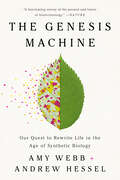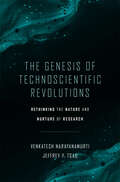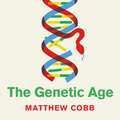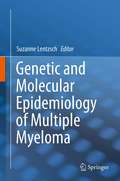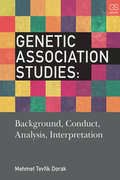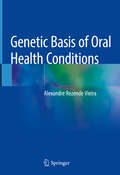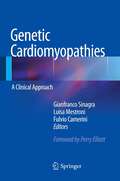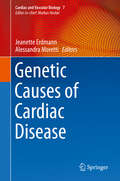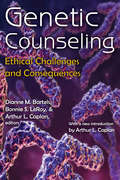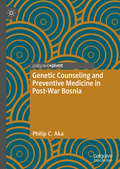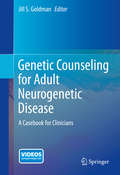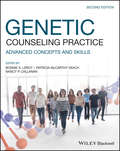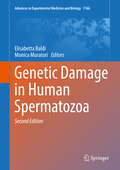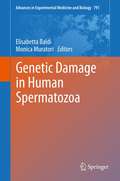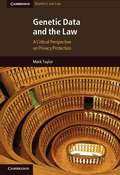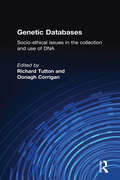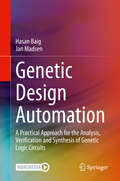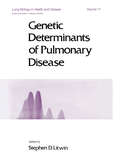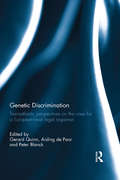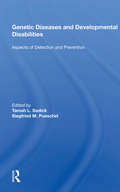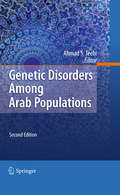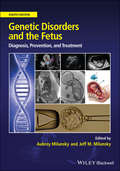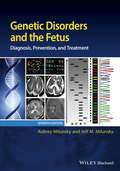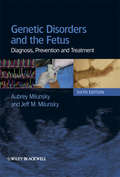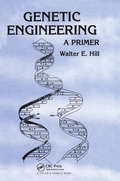- Table View
- List View
The Genesis Machine: Our Quest to Rewrite Life in the Age of Synthetic Biology
by Amy Webb Andrew HesselNamed one of The New Yorker's BEST BOOKS OF 2022 SO FARThe next frontier in technology is inside our own bodies. Synthetic biology will revolutionize how we define family, how we identify disease and treat aging, where we make our homes, and how we nourish ourselves. This fast-growing field—which uses computers to modify or rewrite genetic code—has created revolutionary, groundbreaking solutions such as the mRNA COVID vaccines, IVF, and lab-grown hamburger that tastes like the real thing. It gives us options to deal with existential threats: climate change, food insecurity, and access to fuel. But there are significant risks. Who should decide how to engineer living organisms? Whether engineered organisms should be planted, farmed, and released into the wild? Should there be limits to human enhancements? What cyber-biological risks are looming? Could a future biological war, using engineered organisms, cause a mass extinction event? Amy Webb and Andrew Hessel&’s riveting examination of synthetic biology and the bioeconomy provide the background for thinking through the upcoming risks and moral dilemmas posed by redesigning life, as well as the vast opportunities waiting for us on the horizon.
The Genesis of Technoscientific Revolutions: Rethinking the Nature and Nurture of Research
by Venkatesh Narayanamurti Jeffrey Y. TsaoResearch powers innovation and technoscientific advance, but it is due for a rethink, one consistent with its deeply holistic nature, requiring deeply human nurturing. Research is a deeply human endeavor that must be nurtured to achieve its full potential. As with tending a garden, care must be taken to organize, plant, feed, and weed—and the manner in which this nurturing is done must be consistent with the nature of what is being nurtured. In The Genesis of Technoscientific Revolutions, Venkatesh Narayanamurti and Jeffrey Tsao propose a new and holistic system, a rethinking of the nature and nurturing of research. They share lessons from their vast research experience in the physical sciences and engineering, as well as from perspectives drawn from the history and philosophy of science and technology, research policy and management, and the evolutionary biological, complexity, physical, and economic sciences. Narayanamurti and Tsao argue that research is a recursive, reciprocal process at many levels: between science and technology; between questions and answer finding; and between the consolidation and challenging of conventional wisdom. These fundamental aspects of the nature of research should be reflected in how it is nurtured. To that end, Narayanamurti and Tsao propose aligning organization, funding, and governance with research; embracing a culture of holistic technoscientific exploration; and instructing people with care and accountability.
The Genetic Age: Our Perilous Quest To Edit Life
by Matthew Cobb'Brilliant .. I cannot recommend this book strongly enough' - Henry Marsh, New Statesman (about The Idea of the Brain)A new gene editing technology, invented just seven years ago, has turned humanity into gods. Enabling us to manipulate the genes in virtually any organism with exquisite precision, CRISPR has given scientists a degree of control that was undreamt of even in science fiction.But CRISPR is just the latest, giant leap in a long journey to master genetics. The Genetic Age shows the astonishing, world-changing potential of the new genetics and the possible threats it poses, sifting between fantasy and the reality when it comes to both benefits and dangers.By placing each phase of discovery, anticipation and fear in the context of over fifty years of attempts to master the natural world, Matthew Cobb, the Baillie-Gifford-shortlisted author of The Idea of the Brain, weaves the stories of science, history and culture to shed new light on our future. With the powers now at our disposal, it is afuture that is almost impossible to imagine - but it is one we will create ourselves.
Genetic and Molecular Epidemiology of Multiple Myeloma
by Suzanne LentzschMultiple myeloma is a plasma cell malignancy characterized by complex heterogenous cytogenetic abnormalities that accounts for 1.4% of all cancers, and approximately 10% of hematologic malignancies. The clinical manifestations of multiple myeloma include lytic bone lesions, cytopenia, hypercalcemia, renal dysfunction, hyperviscosity of the blood, immunodeficiency, and peripheral neuropathy. Based on the clinical and genetic data, probably all cases of multiple myeloma arise from an asymptomatic monoclonal gammopathy of unknown significance. The exact mechanism of the transition from MGUS to overt multiple myeloma is still not well understood. Recent oncogenomic studies have further advanced our understanding of the molecular pathogenesis of multiple myeloma. This book will give a comprehensive overview of the genetic and molecular epidemiology of multiple myeloma in order to get a more refined and conclusive understanding of this disease.
Genetic Association Studies: Background, Conduct, Analysis, Interpretation
by Mehmet Tevfik DorakGenetic Association Studies is designed for students of public health, epidemiology, and the health sciecnes, covering the main principles of molecular genetics, population genetics, medical genetics, epidemiology and statistics. It presents a balanced view of genetic associations with coverage of candidate gene studies as well as genome-wide association studies. All aspects of a genetic association study are included, from the lab to analysis and interpretation of results, but also bioinformatics approaches to causality assessment. The role of the environment in genetic disease is also highlighted. Genetic Association Studies will enable readers to understand and critique genetic association studies and set them on the way to designing, executing, analyzing, interpreting, and reporting their own.
Genetic Basis of Oral Health Conditions
by Alexandre Rezende VieiraThis book explains the genetic basis of a wide range of dental disorders, including dental caries, periodontitis, congenital anomalies, malocclusions, orofacial pain, dental implant failure, and cancer. Such conditions are typically multifactorial or complex, with involvement of more than one gene as well as environmental influences. A sound grasp of this framework is ever more important, given the emergence of consumer genomics, including direct-to-consumer genetic testing. Dental professionals now need to understand why one person is susceptible to a particular oral health condition while a first-degree relative either does not develop the condition or does so in a less severe form. Knowledge of how genes operate in the susceptible host is essential if patients are to be offered accurate advice about their risks. The information provided in this book will assist in the delivery of effective personalized dental care through optimization of preventive strategies. It will enable the practitioner to explain the extent to which a patient’s condition is pure "bad luck", whether that bad luck can be changed by behavioral choices, and how many of our behaviors are influenced by genes.
Genetic Cardiomyopathies
by Fulvio Camerini Gianfranco Sinagra Luisa MestroniIn the last decade, genetics has been emerging as a primary issue in the diagnosis and management of cardiomyopathies. This book is intended to be a state-of-the-art monograph on these diseases, describing their genetic causes, defining the molecular basis and presenting extensive descriptions of genotype-phenotype correlations. Other chapters are focused on the role of clinical observation, on ECG and echocardiography. With its highlight on the most recent discoveries in the field of molecular genetics as well as on the correct clinical approach to patients with heart muscle disease, the book is aimed at physicians and clinical cardiologists with a particular interest in myocardial diseases and in their genetic causes.
Genetic Causes of Cardiac Disease (Cardiac and Vascular Biology #7)
by Jeanette Erdmann Alessandra MorettiThis book provides a comprehensive summary of the latest developments in the field of the genomics of cardiac disease. Written and edited by leading clinicians and scientists involved in the analysis and therapy of genetic cardiac disorders, it discusses the genetic causes of a variety of cardiac diseases, such as the complex genetics and etiology of congenital heart diseases. It also explores sex differences in prevalent diseases, genetics-based therapeutic strategies and the use of various animal models and alternatives. The book is intended for research scientists and clinical scientists in the cardiovascular field, human geneticists and cardiologists.
Genetic Counseling: Ethical Challenges and Consequences
by Dianne M. Bartels Bonnie S. LeRoy Arthur L. CaplanGenetic counseling is fairly new. The fact that the field is an accepted professional enterprise in universities, clinics, and hospitals throughout the United States is remarkable. The contributors argue that genetics and medicine rest on beliefs widely held in American society. Scientific progress is good, and highly sophisticated technologies are appropriate means to solving medical problems. The better understanding they gain about the nature and evolution of disease, the more prepared clinicians will be to treat and prevent future occurrence of disease. A belief that medicine, including genetic medicine, is clear, factually based, and objective undergirds the strategies and norms of genetic counseling. This collection of original papers explores the history, values, and norms of that process, with focus on the value of non-directiveness in counseling practice. The contributors' examination of genetic counseling issues serves as a foundation from which to address the ethical, legal, and policy considerations of clinical genetics.
Genetic Counseling and Preventive Medicine in Post-War Bosnia
by Philip C. AkaGenetic Counseling and Preventive Medicine in Post-War Bosnia offers a unique new perspective to longstanding debates on healthcare reforms in Bosnia. In this penetrating analysis, Philip C. Aka argues that twenty-five years after the ethnic war that shook Bosnia and Herzegovina to its foundations, healthcare reforms are a function of preventive medicine, defined as genetic counselling, backed by tobacco and alcohol control. At its core, the book offers a fresh examination of healthcare reforms in Bosnia set in the multidisciplinary field of bioethics, supplemented by comparative health studies, and comparative human rights. By offering an extensive list of electronically accessible literature on healthcare accessible in the public domain, Aka delivers an exemplar of research possibilities in the Information Age.
Genetic Counseling for Adult Neurogenetic Disease
by Jill S. GoldmanThe adult patient diagnosed with or at risk for a neurogenetic disease has many questions and concerns for the genetic counselor, the neurologist, and other practitioners. Because of the emotional and potentially life-altering impact of these diseases on the patient and family, counseling can be especially challenging. A rare hands-on guide to the subject, Genetic Counseling for Adult Neurogenetic Disease deals with core issues that differentiate adult neurogenetic counseling from its more familiar pediatric counterpart. This innovative book with accompanying videos is designed to fill in deficits in this area typical of training programs in genetic counseling (which have pediatrics and prenatal concentrations) and neurology (which rarely cover genetic counseling). For each condition featured, chapters include a detailed overview of genetic symptoms, diagnostic criteria, and management, plus guidelines for asking, and answering, pertinent questions. The major concentration, however, is on genetic counseling issues and case histories illustrating these issues. As an added dimension, the accompanying videos depict representative issues and challenges in genetic counseling for specific diseases in addition to the basics of a neurological examination. Among the conditions discussed: Movement disorders, including Parkinson's disease. Dementias, including Alzheimer's disease. Stroke. Motor neuron diseases. Neuropathies and channelopathies. Adult muscular dystrophies. Neurocutaneous syndromes. Plus a section on neurological and neuropsychological evaluation. This is information that will stay relevant as technologies change and genetic understanding evolves. Genetic Counseling for Adult Neurogenetic Disease offers advanced clinical wisdom for genetic counselors as well as neurologists, neuropsychologists, and other referring clinicians.
Genetic Counseling Practice: Advanced Concepts and Skills (Genetic Counseling In Practice Ser.)
by Bonnie S. LeRoy Patricia McCarthy Veach Nancy P. CallananThe second edition of Genetic Counseling Practice: Advanced Concepts and Skills, provides in-depth content regarding the advanced competencies for meeting patient needs across the changing landscape of genetic counseling practice. The content aligns with the Reciprocal Engagement Model (REM) of practice which integrates the biomedical knowledge and psychosocial aspects of genetic counseling. This edition has been revised and expanded to reflect advances made in the present-day field. Edited by a team two genetic counselors and a psychologist, the chapters offer a holistic picture of genetic counseling. Chapter authors are all recognized experts in the profession. The chapters are grounded in evidence-based practice and research. Each chapter includes learning activities to help readers apply concepts and skills. Featured topic areas include: Meeting the needs of culturally diverse patients Addressing challenging patient dynamics Working with children, adolescents and families Using emerging service delivery models for genetic counseling Engaging in self-reflective, deliberate practice Promoting genetic counselor professional development Genetic Counseling Practice is an indispensable guide to the complex and evolving field of genetic counseling, and this updated second edition will help practitioners and trainees alike navigate its most pressing and practical challenges with skill and care.
Genetic Damage in Human Spermatozoa (Advances in Experimental Medicine and Biology #1166)
by Elisabetta Baldi Monica MuratoriThere are several types of damage that can be found in the male gamete. This book covers the genetic damage in spermatozoa that can originate during spermatogenesis, or during transit in both male and female genital tracts. Damage can also be due to ageing, environmental or iatrogenic conditions, as well as to the protocols to cryopreserve and to select spermatozoa in assisted reproduction techniques. The purpose of this book is to provide a comprehensive resource for all possible DNA damages in sperm, the relation to fertility and infertility, and possible transgenerational heritable effects.
Genetic Damage in Human Spermatozoa
by Monica Muratori Elisabetta BaldiThere are several types of damage that can be found in the male gamete. Genetic damage in spermatozoa can originate during spermatogenesis, or it can originate during transit in both male and female genital tracts. Damage can also be due to ageing, environmental or iatrogenic conditions, as well as to the protocols to cryopreserve and to select spermatozoa in assisted reproduction techniques. The purpose of this book is to provide a comprehensive resource for all possible DNA damages in sperm, the relation to fertility and infertility, and possible transgenerational heritable effects.
Genetic Data and the Law
by Mark TaylorResearch using genetic data raises various concerns relating to privacy protection. Many of these concerns can also apply to research that uses other personal data, but not with the same implications for failure. The norms of exclusivity associated with a private life go beyond the current legal concept of personal data to include genetic data that relates to multiple identifiable individuals simultaneously and anonymous data that could be associated with any number of individuals in different, but reasonably foreseeable, contexts. It is the possibilities and implications of association that are significant, and these possibilities can only be assessed if one considers the interpretive potential of data. They are missed if one fixates upon its interpretive pedigree or misunderstands the meaning and significance of identification. This book demonstrates how the public interest in research using genetic data might be reconciled with the public interest in proper privacy protection.
Genetic Databases: Socio-Ethical Issues in the Collection and Use of DNA
by Richard Tutton Oonagh CorriganGenetic Databases offers a timely analysis of the underlying tensions, contradictions and limitations of the current regulatory frameworks for, and policy debates about, genetic databases. Drawing on original empirical research and theoretical debates in the fields of sociology, anthropology and legal studies, the contributors to this book challenge the prevailing orthodoxy of informed consent and explore the relationship between personal privacy and the public good. They also consider the multiple meanings attached to human tissue and the role of public consultations and commercial involvement in the creation and use of genetic databases. The authors argue that policy and regulatory frameworks produce a representation of participation that is often at odds with the experiences and understandings of those taking part. The findings present a serious challenge for public policy to provide mechanisms to safeguard the welfare of individuals participating in genetic databases.
Genetic Design Automation: A Practical Approach for the Analysis, Verification and Synthesis of Genetic Logic Circuits
by Hasan Baig Jan MadsenThis textbook introduces readers to the recent advances in the emerging field of genetic design automation (GDA). Starting with an introduction and the basic concepts of molecular biology, the authors provide an overview of various genetic design automation tools. The authors then present the DVASim tool (Dynamic Virtual Analyzer and Simulator) which is used for the analysis and verification of genetic logic circuits. This includes methods and algorithms for the timing and threshold value analyses of genetic logic circuits. Next, the book presents the GeneTech tool (A technology mapping tool for genetic circuits) and the methods developed for optimization, synthesis, and technology mapping of genetic circuits. Chapters are followed by exercises which give readers hands-on practice with the tools presented. The concepts and algorithms are thoroughly described, enabling readers to improve the tools or use them as a starting point to develop new tools. Both DVASim and GeneTech are available from the developer’s website, free of charge. This book is intended for a multidisciplinary audience of computer scientists, engineers and biologists. It provides enough background knowledge for computer scientists and engineers, who usually do not have any background in biology but are interested to get involved in this domain. This book not only presents an accessible basic introduction to molecular biology, it also includes software tools which allow users to perform laboratory experiments in a virtual in-silico environment. This helps newbies to get a quick start in understanding and developing genetic design automation tools. The third part of this book is particular useful for biologists who usually find it difficult to grasp programming and are reluctant to developing computer software. They are introduced to the graphical programming language, LabVIEW, from which they can start developing computer programs rapidly. Readers are further provided with small projects which will help them to start developing GDA tools.
Genetic Determinants of Pulmonary Disease
by Stephen. D. LitwinThis book provides a current and integrated approach to the subject of genetic determinants of pulmonary disease with emphasis on physiologic derangements and genetic mechanisms. It describes the epidemiologic-genetic approach to chronic pulmonary disease.
Genetic Discrimination: Transatlantic Perspectives on the Case for a European Level Legal Response
by Gerard Quinn Aisling De Paor Peter BlanckAs genetic technologies advance, genetic testing may well offer the prospect of detecting the onset of future disabilities. Some research also forwards that certain behavioural profiles may have a strong genetic basis, such as the determination to succeed, or the propensity for risk-taking. As this technology becomes more prevalent, there is a danger that genetic information may be misused by third parties and that particular genetic profiles may be discriminated against by employers, by providers of social goods and services, such as insurance companies and even by educational facilities. This book explores the different forms and potential uses of genetic testing. Drawing together leading experts in disability law, bioethics, health law and a range of related fields, it highlights the ethical and legal challenges arising as a result of emerging and rapidly advancing genetic science. On examining transatlantic perspectives on the matter, chapters in the book ask whether the US Genetic Information Nondiscrimination Act (GINA) is proving to be an effective tool in addressing the issue of genetic discrimination and alleviating fears of discrimination. The book also reviews what insights may be gained from GINA within employment and health insurance contexts, and asks how the UN Convention on the Rights of Persons with Disabilities (CRPD) may impact similar debates within the European Union. The book focuses particularly on the legislative and policy framework in the European Union, with an emphasis on the gaps in protection and the scope for specific legislative action in this area. This book will be of great interest to scholars and students of discrimination law, bioethics and disability law, and will be of considerable use to legal practitioners, medical practitioners and policy-makers in this area.
Genetic Diseases And Development Disabilities: Aspects Of Detection And Prevention
by Tamah L SadickAdvances in medical genetics during the past two decades have made possible the detection and prevention of many genetic disorders and developmental disabilities. The emphasis of this book is on the application of these new developments to real-life situations. Covering homozygote newborn screening, heterozygote detection in the community, and pren
Genetic Disorders Among Arab Populations
by Ahmad S. TeebiArab populations have their "own" genetic disorders, both universal and particular. Genetic diversity within these source populations, along with the fact that the rates of inbreeding are often high and family sizes are often large, constitute conditions that facilitate the emergence and detection of phenotypes explained notably by autosomal recessive inheritance; in which case, the use of homozygosity gene mapping can facilitate the discovery of the corresponding genes. The present book includes 5 parts dealing with various aspects that relate to the genetic structure of Arabs and minorities within the Arab world as well as genetic disorders prevalent in this part of the world. It includes updated reviews of the genetic disorders in various Arab countries and geographic regions. The focus is primarily, but not exclusively, on the group of single-gene disorders with particular emphasis on autosomal recessive conditions. It further includes epidemiological and clinical data as well as inheritance patterns, mutation and polymorphism data, and available haplotype analysis data. The ethnic and genetic diversity of the Arab populations is discussed as well as aspects of genetic counseling practice in this region together with a proposal for an ethical framework for genetic research and prevention of genetic disorders. The target audience of this book includes human and medical geneticists, genetic counselors, researchers, medical specialists dealing with Arab patients or practicing in Arab countries, medical and genetic counseling students, and nurses.
Genetic Disorders and the Fetus: Diagnosis, Prevention and Treatment
by Aubrey MilunskyGenetic Disorders and the Fetus: Diagnosis, Prevention and Treatment, Eighth Edition is the eagerly awaited new edition of the discipline-leading work that has been at the forefront of diagnosis, prevention, and treatment of fetal genetic disorders for over 36 years. This timely update builds on the foundations of preconception and prenatal genetic counseling and the original pillars of prenatal diagnosis while also providing authoritative coverage of exciting developments in non-invasive genetic testing and rapidly developing molecular techniques. Chapters are once again authored by internationally recognized authorities in the field of prenatal diagnosis. The editors have brought together an invaluable collection of evidence-based facts bolstered by knowledge and decades of experience in the field.
Genetic Disorders and the Fetus
by Aubrey Milunsky Jeff M. MilunskyProfessor Milunsky's book has been at the forefront of this field for over 30 years, in sixeditions. The new edition will continue to be written by internationally recognized authorities in the field. The contents will be updated to include the major changes afoot in the cytogenetics of prenatal diagnosis where chromosomal microarray has taken hold and is likely to seriously replace routine chromosome analysis. This aspect, enormous advances in prenatal molecular diagnosis, advances in preimplantation diagnosis and non-invasive prenatal diagnosis via circulating fetal DNA and RNA in mother's blood, will feature prominently in the next edition.
Genetic Disorders and the Fetus
by Jeff Milunsky Aubrey MilunskyHighly Commended in the Obstetrics and Gynaecology category of the 2010 BMA Medical Book CompetitionBrand new edition of the world's leading text on prenatal diagnosisThis 6th Edition of Genetic Disorders and the Fetus maintains it's pre-eminence as the major repository of facts about prenatal diagnosis. It provides a critical analysis and synthesis of established and new knowledge based on the long experience of authorities in their respective fields. A broad international perspective is presented through authoritative contributions from authors in 11 countries. All chapters and guidelines have been updated to reflect contemporary practice. New chapters have been introduced on:The use of chromosomal microarrays in prenatal diagnosisThe social, legal and public policy issues with special reference to international approachesThe important peroxisomal and related fatty acid oxidation disordersExtensive tables and clear illustrations assist in differential diagnosis, gene identification and diagnostic modes. The recognition of many new and unresolved challenges should provide inspiration for novel research initiatives. The guidance provided and the insights and perspectives of these authors make this volume a valuable and indispensable resource for all whose focus is securing fetal health through prenatal diagnosis.Genetic Disorders and the Fetus: Diagnosis, Prevention and Treatment is an essential resource for all engaged in prenatal genetic diagnosis, especially obstetricians, maternal-fetal medicine specialists, medical geneticists, genetic counsellors, and pediatricians, but also many other specialties.
Genetic Engineering: A Primer
by Walter E. HillGenetic Engineering: A Primer presents the growing field of biotechnology to non-science majors and other general interest readers. The author examines the natural forces that change genetic information and the ways in which scientists have learned to engineer these genetic changes. With a wealth of information flooding the popular press, including
